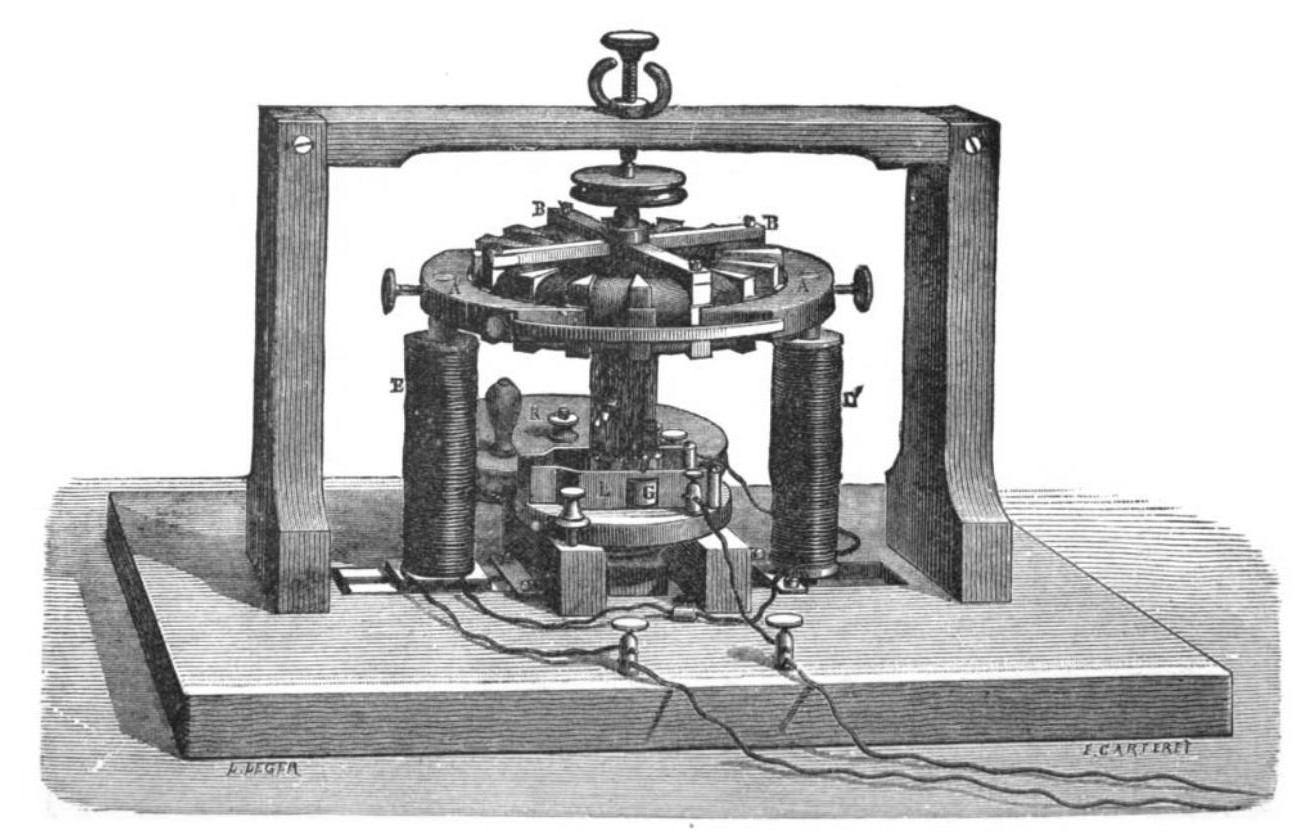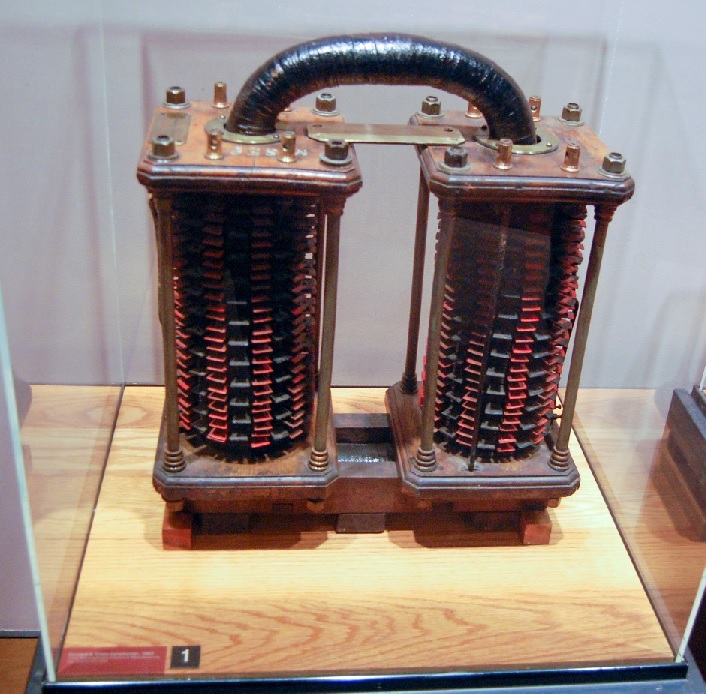The History of Power
In 1831, English scientist Michael Faraday (9/22/1791 – 8/25/1867) realized that an electric current could be produced by passing a magnet through a cylinder wrapped in copper wire. This was later called “electromagnetic induction”.

Faraday's Induction Experiment
The drawing above represents Michael Faraday’s experiment showing electromagnetic induction. The battery to the right is charging the coil of copper wire (A). As the coil is moved in and out of the cylinder, also wrapped in copper wire (B), current from the cylinder is measured by the galvanometer to the left (G).
In 1832, French inventor Hippolyte Pixii (1808–1835) built a generator using Faraday’s principles of electromagnetic induction.
A drawing of Pixii’s invention can be seen below.

Pixii's Generator
At the top of the wooden frame are two cylinders wrapped in copper coil forming electromagnets. Below that is a horseshoe magnet attached to a hand crank. As the magnet turns underneath the two electromagnets, current is created.
Because both of the poles of the magnet went through the copper wound coil, the current direction would change essentially creating an “alternating current”. To “fix” this “problem”, a commutator was added to convert the AC to DC. All a commutator does is takes part of the alternating current and either reverses it or eliminates half of the alternating waveform. In Pixii’s case, it was simply a contact that alternated with the direction of the magnet, essentially taking only half and wasting the other half.
Unfortunately, the results of these types of generators were spikes of low power making them not very practical for delivering power beyond charging batteries. But in 1860, that would change.
Italian physicist Antonio Pacinotti (6/17/1841-3/24/1912) invented a DC generator with much smoother power output by using a wire wrapped ring as an armature.

Pacinotti's Dynamo
In 1871, Belgian engineer Zénobe Gramme (4/4/1826-1/20/1901) improved on Pacinotti’s invention with his “Gramme Ring”; a new rotor design that allowed the generator to output much more power. The new generator was called a “Gramme Machine”.
War of the Currents -
In 1815, in an attempt to bring safer lighting apparatus to coal mines, Cornish chemist Sir Humphry Davy (12/17/1778-5/29/1829) used a 2,000-cell battery to generate a four inch arc of light between two charcoal sticks called a “Davy Lamp”. While this experiment was not very practical for producing light, it did reveal that electricity could produce high intensity lighting if the details could be worked out and was the predecessor of what was to be called “arc lighting”.
In 1876, Russian engineer Pavel Yablochkov (9/14/1847-3/31/1894) invented the latest version of an arc lamp called the “Yablochkov candle”.
Below is a drawing of the Yablochkov Candle. The lamp had two carbon rods in parallel (a and b in the figure below), isolated from one another with a layer of plaster of Paris. A fuse wire (c) connects the two carbon rods and when DC was applied to the fuse using a Gramme Machine, the fuse would burn and in turn ignite the carbon rods and plaster of Paris. The lamp would burn for two hours and could not be reused.

Yablochkov candle
In 1878, American inventor Thomas Edison (2/11/1847 – 10/18/1931) started working on improving on the arc lamp. In 1879, Edison created a light bulb that lasted 13.5 hours. Later, using carbonized bamboo, he created a light bulb that lasted 1200 hours!
Edison realized an idea of installing his light bulbs and delivering DC power to businesses and homes, and in 1882 the Edison Illuminating Company was established. The advantages of DC were that it worked well with Edison’s newly invented incandescent light bulbs and could be used to charge batteries that could be used when DC from a city center’s generator was not available.
Unfortunately for Mr. Edison, DC is not good for long distances. In fact, to avoid significant drops in voltage, generators were typically installed in city centers and only had a one mile range.
In 1881, British engineer John Dixon Gibbs (1834-1912) and French inventor Lucien Gaulard (1850 – November 26, 1888) invented an AC transformer that could be easily manufactured and handle large amounts of power. The transformer was exhibited in London, and again in Turin, Italy in 1884, where it was later adopted for that city’s lighting system.
The transformer got the attention of American businessman George Westinghouse (10/6/1846-3/12/1914), so he bought the rights to use it in the United States.

Gaulard & Gibbs transformer at the National Museum of American History
In 1885, American physicist William Stanley Jr. (11/28/1858) was hired to develop an electrical system to compete with Edison’s using the Gibbs-Gaulard design. The next year, this was rolled out into a new power distribution system for the main street of Great Barrington, Massachusetts. This system used a higher voltage over a longer distance than DC that could be stepped down to lower voltages for use in indoor lighting.
Through a series of acquisitions of other AC generating electric companies and patents for any incandescent lamp patents not owned by Edison, all of the United States electricity demands were fulfilled by either Westinghouse’s AC or Edison’s DC. So, in an attempt to regain market share, Edison began a smear campaign against alternating current citing how “unsafe” it was.
In 1881, a Buffalo, NY dentist by the name of Alfred P. Southwick (1826-1898) utilized high voltage AC to euthanize stray dogs at the Buffalo SPCA. Within that same year, Southwick published ideas in scientific journals on using the same method for capital punishment.
In 1888, American electrical engineer Harold P. Brown (9/16/1857 - ?/1944) wrote a letter to the New York Post stating how dangerous AC was and that the only reason safer, DC power wasn’t used was because utility companies did not want to invest in the heavier copper lines required to deliver DC power, which put people in constant risk of death. Upon hearing about Brown’s letter to the paper, Thomas Edison allowed Brown the use of his West Orange, NJ laboratory to experiment on the dangers of alternating current.

Dog electrocution diagram
Brown experimented by electrocuting several dogs, and eventually held a demonstration at Columbia College showing that 1000V DC would not kill a dog, but 300V AC would. Brown then went on to have legislation passed to have more control over AC installations and in 1889 New York City passed legislation to put AC transmission lines underground.
Later in 1888, when electrocution started to be used for capital punishment, Edison used this as a talking point as to how alternating current was more dangerous than direct current.
Ultimately, the mergers and acquisitions that created the Edison General Electric company in 1889 reduced Edison’s controlling interest in the company. Edison decided he was no longer interested in the electric lighting business and began focusing on an iron ore refining project instead. That same year, Edison Electric’s own subsidiaries lobbied to add AC power transmission to their systems and by 1890, Edison Machine Works was developing AC-based equipment.
In 1892, Edison General Electric merged with Westinghouse’s biggest AC rival, Thomson-Houston, forming General Electric (dropping the “Edison” from the name). Since the board of directors was from the Thomson-Houston company, Edison was completely pushed out and the migration of Edison’s original DC delivery systems to AC began to move forward. General Electric, at this time, controlled three-quarters of the U.S’s electrical business.
What does Nikola Tesla have to do with the War of the Currents? -
Despite the fact that to many, the “War of the Currents” is often told as a Edison vs. Tesla story, the reality is that “war” was largely over by the time Tesla’s contributions had an impact on the “war”.
In 1882, Croatian born engineer Nikola Tesla (7/10/1856 – 1/7/1943) landed a job working for Edison’s company in France, installing Edison’s DC based lighting system. In 1885, Tesla emigrated to the United States working for Edison’s Machine Works in New York city. He worked there for six months before quitting.
In 1888, Westinghouse paid Tesla to license a number of his patents for a poly-phase brushless AC induction motor. This was arguably Tesla’s greatest accomplishment as it worked without a commutator. Instead of altering the magnetic poles or the motor’s rotor, Tesla’s invention altered the magnetic field of the rotor. But due to the large investments Westinghouse had made in mergers, patent licensing and hiring engineers, developing and using Tesla’s motor had to be put on hold for a while.

Tesla's AC induction motor
In 1893, Westinghouse’s engineer Benjamin Lamme (1/12/1864 - 7/8/1924) made improvements to Tesla’s design making it much more efficient. That same year, Westinghouse demonstrated the new system by lighting the entire World’s Columbian Exposition in Chicago. This demonstration lead to Westinghouse getting the contract for building the AC generator system at Adams Power Plant at Niagara Falls.